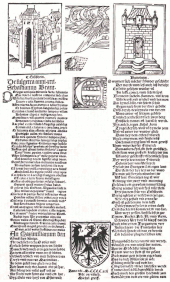| Ensisheim meteorite | |
|---|---|
 Ensisheim meteorite in the town's museum Ensisheim meteorite in the town's museum | |
| Type | Chondrite |
| Class | Ordinary chondrite |
| Group | LL6 |
| Country | France |
| Region | Ensisheim |
| Observed fall | Yes |
| Fall date | 7 November 1492 |
| Found date | 7 November 1492 |
| TKW | 127 kg (280 lb) |
 The fall of the meteorite, as depicted in the Nuremberg Chronicle from 1493. The fall of the meteorite, as depicted in the Nuremberg Chronicle from 1493. | |
The Ensisheim meteorite is a stony meteorite that fell on November 7, 1492 in a wheat field outside the walled town of Ensisheim in then Alsace, Further Germany (now France). The meteorite can still be seen in Ensisheim's museum, the sixteenth-century Musée de la Régence. It is the oldest stony European meteorite fall from which there is still some meteoritic material preserved.
Composition
The meteorite is an LL6 ordinary chondrite, weighing 127 kilograms (280 lb); it was described as triangular in shape, and it created a 1-meter (3 ft 3 in) deep hole upon impact.
Contemporary response

The fall of the meteorite through the Earth's atmosphere was observed as a fireball at a distance of up to 150 kilometers from where it eventually landed. Residents of the walled town and nearby farms and villages gathered at the location to raise the meteorite from its impact hole and began removing pieces of it. A local magistrate interfered with the destruction of the stone, in order to preserve the object for King Maximilian, the son of the reigning Holy Roman Emperor Frederick III. A piece of the meteorite was sent to Cardinal Piccolomini (later Pope Pius III) at the Vatican along with a number of related verses written by Sebastian Brant.
King Maximilian, who was on his way to a campaign against France, ordered for it to be preserved at a local church. He and his advisors decided that the meteorite was a good omen. It was subsequently utilized for propaganda against France. One reason for the quick spreading of the story throughout Europe was the loud volume of the meteorite impact (contemporaries reportedly heard the sound at least 100 miles away). Another reason was the use of broadsheets with dramatic pictures under the direction of the poet Sebastian Brandt (1458–1521).
Brandt created broadsheets in Latin and German with a poem about the meteorite, describing it as an omen for the king's success in battles against France.
Two months later, Maximilian defeated a far larger French army than his own at the Battle of Senlis, which prompted Brandt to produce another broadsheet reminding the readers about his prediction. In 1493, he wrote another broadsheet. By this time, the French were no longer a threat (because Maximilian had just signed the Treaty of Senlis with them), so Brandt directed his readers' attention towards the Turks.
Brandt, a satirist and author of Das Narrenschiff, also described the meteorite and its fall in the poem "Loose Leaves Concerning the Fall of the Meteorite". The fall is also described in Folio 257 of the Nuremberg Chronicle.
The German artist Albrecht Dürer possibly sketched his observation of the meteorite's fall on the reverse of his painting St. Jerome in the Wilderness.
References
- McSween, Jr., Harry Y.; Bennett III, Marvin E.; Jarosewich, Eugene (1991). "The Mineralogy of Ordinary Chondrites and Implications for Asteroid Spectrophotometry". Icarus. 90 (1): 107–116. Bibcode:1991Icar...90..107M. doi:10.1016/0019-1035(91)90072-2.
- ^ McSween, Harry Y. (1999). Meteorites and Their Parent Planets (2nd ed.). Cambridge : Cambridge University Press. ISBN 0-521-58303-9.
- ^ A Contemporary Account of the Ensisheim Meteorite, 1492 Rowland, I. D. (1990), Meteoritics, vol. 25, no. 1, p. 19.
- ^ Hayton, Darin (2015). The Crown and the Cosmos: Astrology and the Politics of Maximilian I. University of Pittsburgh Press. p. 51. ISBN 978-0-8229-8113-8. Retrieved 7 November 2021.
- Reich, Aaron. "Meteor impacts Ensisheim 529 years ago in oldest recorded impact". The Jerusalem Post | JPost.com. Retrieved 7 November 2021.
- Golia, Maria (2015). Meteorite: Nature and Culture. Reaktion Books. ISBN 978-1-78023-547-9. Retrieved 7 November 2021.
- ^ Marvin, Ursula B. (1992). "The meteorite of Ensisheim: 1492 to 1992". Meteoritics. 27 (1): 28–72. Bibcode:1992Metic..27...28M. doi:10.1111/j.1945-5100.1992.tb01056.x. Retrieved 4 March 2012.
External links
 Media related to Ensisheim meteorite at Wikimedia Commons
Media related to Ensisheim meteorite at Wikimedia Commons
| Meteorites and meteoritics | |||||||||||||||||||||||
|---|---|---|---|---|---|---|---|---|---|---|---|---|---|---|---|---|---|---|---|---|---|---|---|
| Meteorite... | |||||||||||||||||||||||
| Classification |
| ||||||||||||||||||||||
| Mineralogy and petrology |
| ||||||||||||||||||||||
| Lists |
| ||||||||||||||||||||||